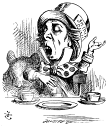Search us!
Search The Word Detective and our family of websites:
This is the easiest way to find a column on a particular word or phrase.
To search for a specific phrase, put it between quotation marks. (note: JavaScript must be turned on in your browser to view results.)
Ask a Question! Puzzled by Posh?
Confounded by Cattycorner?
Baffled by Balderdash?
Flummoxed by Flabbergast?
Perplexed by Pandemonium?
Nonplussed by... Nonplussed?
Annoyed by Alliteration?

Don't be shy!
Send in your question!
Columns from 1995 to 2006 are slowly being added to the above archives. For the moment, they can best be found by using the Search box at the top of this column.
 If you would like to be notified when each monthly update is posted here, sign up for our free email notification list.
If you would like to be notified when each monthly update is posted here, sign up for our free email notification list.
Trivia
All contents herein (except the illustrations, which are in the public domain) are Copyright © 1995-2020 Evan Morris & Kathy Wollard. Reproduction without written permission is prohibited, with the exception that teachers in public schools may duplicate and distribute the material here for classroom use.
Any typos found are yours to keep.
And remember, kids,
Semper Ubi Sub Ubi
|
 Semper Ubi Sub Ubi readme:
First off, a profound thank you to all the folks who have subscribed and contributed over the past few months. Your support has been an enormous help.
Secondly, over there in the right sidebar is an ad for How Come?: Every Kid’s Science Questions Explained , the latest book by Kathy Wollard (who happens to be my wife). It’s a completely revised and rewritten selection of fascinating science questions and lively answers drawn from the previous three How Come? books. More than 400 pages long and full of amusing illustrations, it’s both rigorously researched and lucidly and entertainingly written. Trust me on this — I was there. Anyway, Amazon is selling both the paperback and the Kindle edition, but the paperback is much bigger, easier to read, much more fun, doesn’t need batteries and will still work after the cyber-apocalypse, so you should buy that version. Plus it doesn’t report what page you’re reading to Jeff Bezos. Anyway, check it out. (Note: the Amazon page is a bit confusing because they also list the first three How Come books (How Come?, How Come? Planet Earth, and How Come in the Neighborhood), but this 2014 edition, a compendium of the best of all three, is the one you want.) , the latest book by Kathy Wollard (who happens to be my wife). It’s a completely revised and rewritten selection of fascinating science questions and lively answers drawn from the previous three How Come? books. More than 400 pages long and full of amusing illustrations, it’s both rigorously researched and lucidly and entertainingly written. Trust me on this — I was there. Anyway, Amazon is selling both the paperback and the Kindle edition, but the paperback is much bigger, easier to read, much more fun, doesn’t need batteries and will still work after the cyber-apocalypse, so you should buy that version. Plus it doesn’t report what page you’re reading to Jeff Bezos. Anyway, check it out. (Note: the Amazon page is a bit confusing because they also list the first three How Come books (How Come?, How Come? Planet Earth, and How Come in the Neighborhood), but this 2014 edition, a compendium of the best of all three, is the one you want.)
Onward. I suppose you’ll be wanting to know what ever became of the February issue. Well, for starters, it got very cold. We didn’t have all the snow that NYC and points east and north got, but it got very cold here. Double-digits-below-zero cold, and that’s the real temperature, not that phony “wind chill” flapdoodle. And if your furnace is not functioning, living in a house built in the 1860s and insulated with horsehair becomes very unpleasant very quickly.
So it’s 4:30 am, a foot of snow on the ground and the temperature is eighteen degrees Fahren-freakin-heit below zero. I’m kneeling in the snow behind the house wearing fourteen layers of clothing, but I can’t cover my face because if I do my breath freezes up on my glasses and I can’t see. In my right hand is a long-handled vegetable brush with plastic bristles. I’m trying to scour ice off the grating on the air intake of our furnace so the damn thing will start working, but it’s slow going because my hand is numb. After I get most of the ice off, I have to search around for a twig I can use to poke the ice out of the holes in the grating. This is the second time tonight I’ve had to come out to do this, and I always seem to go through three or four twigs before I get it clear. The furnace quit about 15 minutes ago and it’s about 50 degrees in the house and falling fast.
The ice on the air intake didn’t get there because it’s snowing, raining or sleeting, because it’s not. The ice is there because the idiots hired by Sears several years ago to install the furnace arranged the exhaust and intake vents backwards, i.e., they put the air intake above the exhaust. So the hot exhaust forms fog, the warm fog rises (duh), and then condenses and freezes on the air intake. We didn’t discover that they had screwed this up until the furnace started cutting out this winter. This only happens in extremely cold weather, but the backwards arrangement also poses a danger of carbon monoxide being sucked into the air intake, so we’re in the process of getting this fixed. Then again, the last time I spoke to Sears Service Center, a weirdly belligerent clown there told me that what I was describing was “impossible,” suggested that we hadn’t actually bought the furnace from Sears Roebuck but from “some guy named Sears,” and hung up on me in mid-sentence.
Anyway, I had the February issue ready to go by early March, not bad considering the level of chaos around here, when the wheels started to come off daily life in a few dozen more ways too tedious to detail here (teeth, car, water softener and filter system, car again…). I promise to do better. Oh look, the grass is growing already! I wonder where I left the lawn tractor.
That’s it for now because there’s a huge thunderstorm* coming at us and I’ve had a thing about lightning ever since I was struck by it back in ought-six. Yeah, that’s how we talk out here in the boonies. Y’all come back soon, hear? And don’t forget to subscribe!
And now, on with the show…
—–
* The power went out for about three hours just after this was written.
Get thee behind me, weird food.
Dear Word Detective: Where does the cooking term “devilled” come from? My wife was talking about “devilled eggs” or “devilled ham” or something, and my curiosity has gotten to me. — Casey Franklin.
That’s a good question, and one I thought I answered a few years ago, but apparently not. What I was thinking of was a sudden spate, back then, of what I called “hidden evil secret stories of words” questions. One reader reported being told not to use the word “luck” because it is supposedly derived from “Lucifer,” which it isn’t. There is no connection whatsoever. Another reader noted that, back in 1997, a county in Texas had adopted “Heaven-O” as their official greeting on the theory that “hello” has some connection to “Hell,” which it doesn’t. That led me to wonder if they would also ban devilled eggs (often made with Hellman’s mayonnaise, after all). That would definitely put a dent in picnics.
The “evil etymology” questions have dwindled in the past few years, but “devilled” (or “deviled,” your choice) eggs and ham endure. “Devil” itself is an interesting word. Our English “devil” began as the Old English “deofol,” from the Greek “diabolos,” meaning “slanderer, accuser” (from “diabellein,” to throw or cast). While in early Jewish and Christian use “diabolos” meant specifically Satan, it could also denote a lower-level demon or evil spirit, or simply a diabolical person. “Devil” has also been used to mean both “lowly assistant” (as in “printer’s devil,” an errand boy in a type-shop) and machines that tear or mangle materials (such as flax or cotton). And, of course, “devil” has long been used for the “charming rogue” male character from Clark Gable to George Clooney, as well as, conversely, a luckless schmuck (“poor devil”).
As a verb, “to devil” originally meant “to act like the devil,” or to torment someone, a sense that also survives in the verb “to bedevil.” One can also, in the “assistant” sense of the noun, “devil” for an employer for long hours but little or no pay.
But the relevant sense of the verb “to devil” that we find in “devilled” is “to grill or prepare with hot condiments or spices,” a 19th-century metaphorical tribute to the supposed broiling environment of Hell. In the case of devilled eggs, “devilling” involves removing the yolk of a hard-boiled egg sliced in half, mixing it with mayonnaise, mustard and other spices, and putting it back in the egg. Devilled ham is a sandwich spread made of ground ham and various spicy seasonings. The original (and most popular) brand of devilled ham in the US is made by Underwood, which features a bright red devil as its logo.
So “devilled” foods don’t actually have any connection to Satan beyond the somewhat hyperbolic connotation of Hades-level hotness. But just the name alone is apparently too much for some folks. According to Wikipedia (as well as actual people I know), devilled eggs are known in much of the US South and Midwest as “stuffed eggs,” “salad eggs,” “dressed eggs” and, inevitably, “angel eggs.” I’m just glad I don’t have to explain that one to some little kid at a picnic (“Yes, angels have wings, but I don’t think they lay eggs”).
None dare call it “moist,” because “moist” is a creepy word.
Dear Word Detective: Now that heating season is here, at least in the northern half of the northern hemisphere, my husband and I were talking about that little device in the wood-stove called a “damper,” the one that throttles back the air supply to the fire to keep it going slower and longer so it lasts all night. It sounds like, but surely cannot be related to, the word “damp” which refers to a slight sogginess. I don’t think that the two words can be related, but I have been wrong before; after all, I am on my second marriage. Can you enlighten us? — Grandma Roses.
I wish we had a wood stove. Personally, I started worrying about the Polar Vortex back in August.
That’s a good question, and your skepticism concerning a possible connection between “damper” and the “soggy” sort of “damp” is entirely justified. But, in this case, wrong. Not only are “damper” and “damp” related, but the “damp” in “damper” is exactly the same word as “damp” meaning “moist.” What we have in “damp” is a word which has radically changed its meaning several times since it first appeared in English in the 14th century, so radically that “damp” today bears little apparent connection to its roots.
The root of “damp” was the Middle Low German word “damp,” based in turn on Germanic roots meaning “vapor,” which was, in fact, the initial meaning of “damp” as an English noun. A “damp” was specifically a noxious vapor, gas or smoke, whether smoke from a open fire, fumes from a cooking stove, or the dangerous gases found in coal mines (known as “black damp” or “choke damp” in the 17th century). It was in the 17th century that “damp” came to also mean fog or vapor of any kind (“I have lost all my bad Symptoms, and am ready to think I could even bear the damps of London.” 1739). But it wasn’t until the 18th century that “damp” was widely used in its modern general sense of “moisture” (initially referring to the wetness of fog or vapor condensed upon an object). Today, of course, this “slightly soggy” sense of “damp” is the only one most people use.
But meanwhile, back in the 16th century, a verb form of “damp” had appeared, derived from the noun. This “to damp” did not, however, mean “to moisten” as we might expect. It meant “to suffocate or choke,” as “damp” in the “smoke” sense would make breathing difficult. That “suffocate” sense quickly led to “damp” meaning “to deaden or dull” a sound or “to extinguish a fire,” and by the 19th century “to damp down” was being used to mean to reduce the intensity of a fire to a low level (without extinguishing it) when it wasn’t needed. “Damp” and “damp down” were also used to mean to mechanically quiet the strings of a piano and, figuratively, to reduce the energy or enthusiasm of a person (“Our hopes of a speedy departure were even now somewhat damped.” 1748).
“Damper” also appeared in the mid-18th century, meaning something that “damps” the spirits (e.g., bad news), takes the edge off one’s appetite, the mechanism that “damps” a piano, and that movable plate or mechanism in a chimney that “damps” a fire by restricting the flow of air (“The heat of the furnace under the boiler was rudely regulated in both machines by a damper.” 1829).
|
Makes a great gift! Click cover for more.  
400+ pages of science questions answered and explained for kids -- and adults!
FROM ALTOIDS TO ZIMA, by Evan Morris
 
|

, the latest book by Kathy Wollard (who happens to be my wife). It’s a completely revised and rewritten selection of fascinating science questions and lively answers drawn from the previous three How Come? books. More than 400 pages long and full of amusing illustrations, it’s both rigorously researched and lucidly and entertainingly written. Trust me on this — I was there. Anyway, Amazon is selling both the paperback and the Kindle edition, but the paperback is much bigger, easier to read, much more fun, doesn’t need batteries and will still work after the cyber-apocalypse, so you should buy that version. Plus it doesn’t report what page you’re reading to Jeff Bezos. Anyway, check it out. (Note: the Amazon page is a bit confusing because they also list the first three How Come books (How Come?, How Come? Planet Earth, and How Come in the Neighborhood), but this 2014 edition, a compendium of the best of all three, is the one you want.)


 can be found
can be found 




Recent Comments